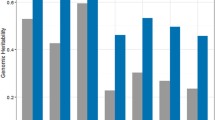Summary
Breeders usually obtain information on a large number of traits in their breeding and selection programmes. However, since some or many of these traits could be related, it is desirable to reduce the number being handled to the barest minimum without sacrificing efficiency. Breeders often use correlations, stepwise multiple regressions and path coefficient analyses to determine the nature of relationships among such characteristics. The objective of this study was to use these statistical methods to determine traits that could be useful in predicting number of bunches (NB), fresh fruit bunch yield (FFB) and mean bunch weight (MBW) for 13 backcross progenies of oil palm (Elaeis sp.) grown in four replications with 12 palms per replication. Data were collected over a period of 3 or 11 years, depending on the trait. Progeny means and individual palm data, averaged across replications and years, were used for each of these analyses.
Results showed that correlations involving individual palm data were similar to the progeny mean correlations. Five to seven traits accounted for about 70–90% of the variations in the dependent variables. Traits that showed the highest correlations with the dependent variables always accounted for the largest proportion of the variation (r2) in multiple regression models, but did not always have the highest direct effect (i.e. path coefficients) in path analysis of the dependent trait. Number of leaves per palm had the highest correlation (r=0.729) with, and accounted for 53.2% of the variation in NB. Path analysis however showed that percentage fruit per bunch (% F/B) was the most important determinant of NB. It exerted the highest direct effect of 0.537. The highest correlation with FFB involved number of leaves (r=0.660), which, in multiple regression models also accounted for the largest proportion (44.0%) of the variation in FFB. Path analysis showed that percentage mesocarp per fruit gave the highest direct effect (p=−0.974) for this trait. It was concluded that various combinations of number of leaves per palm, sex-ratio, percentage fruit per bunch and percentage mesocarp per fruit would be effective as indirect selection criteria for NB, FFB and MBW in this set of material.
Similar content being viewed by others
References
Akpan, E.E.J., R.D., Parimoo & C.O., Obasola, 1982. Assessment of the performance of certain progenies of oil palm (Elaeis guineensis Jacq.) selected for the short stem character. In: The oil palm in agriculture in the eighties. Incorporated Society of Planters, Kuala Lumpur: 101–107.
Corley R.H.V. & B.S. Gray, 1976. Yield and yield components. pp. 77–86. In: R.H.V. Corley, J.J. Hardon & B.J. Woods (Eds). Developments in crop science, I. Oil Palm Research. Elsevier Scientific Publishing Company.
Corley, R.H.V., J.J., Hardon & G.Y., Tan, 1971. Analysis of growth of the oil palm (Elaeis guineensis Jacq.) I. Estination of growth parameters and application in breeding. Euphytica 20: 307–315.
Fakorede, M.A.B., 1979. Interrelationships among grain yield and agronomic traits in a synthetic population of maize. Maydica 24: 181–192.
Fakorede, M.A.B. & B.O., Opeke, 1985. Weather factors affecting the response of maize to planting dates in a tropical rainforest location. Exptal. Agric. 21: 31–40.
Hardon J.J. & R.H.V. Corley, 1976. Pollination. In: Corley R.H.V., J.J. Hardon & B.J. Woods (Eds). Developments in Crop Science I. Oil Palm research, pp 299–305. Elsevier Scientific Publishing Company.
Hartley, C.W.S., 1977. The Oil Palm, Lowe and Brodon Printers Ltd. Norfolk 806 p.
Meunier J. & J.J. Hardon, 1976. Interspecific hybrids between Elaeis guineensis and Elaeis oleifera pp 127–144. In: R.H.V. Corley, J.J. Hardon & B.J. Woods (Eds). Developments in Crop Science I. Oil Palm research. Elsevier Scientific Publishing Company.
Obisesan, I.O., 1981. Evaluation of yield and associated traits in some hybrids of oil palm (Elaeis guineensis Jacq.) Ph. D Thesis University of Ife. 220 p.
Ooi, S.C., J.J., Hardon & S., Phang, 1973. Variability in the Deli dura breeding population of the oil palm (Elaeis guineensis Jacq.) I. components of bunch yield. Malay. Agric. J. 49: 112–121.
Van der Vossen H.A.M., 1974. Towards a more efficient selection for oil yield in the oil palm (Elaeis guineensis Jacquin). Ph.D. Thesis University of Wageningen 107 p.
Wright, S., 1923. Correlation and causation. J. of Agric. Res. 20: 557–585.
Author information
Authors and Affiliations
Rights and permissions
About this article
Cite this article
Oboh, B.O., Fakorede, M.A.B. Interrelations among vegetative, yield and bunch quality traits in short-tem oil palm progenies. Euphytica 46, 7–14 (1990). https://doi.org/10.1007/BF00057614
Received:
Accepted:
Issue Date:
DOI: https://doi.org/10.1007/BF00057614




